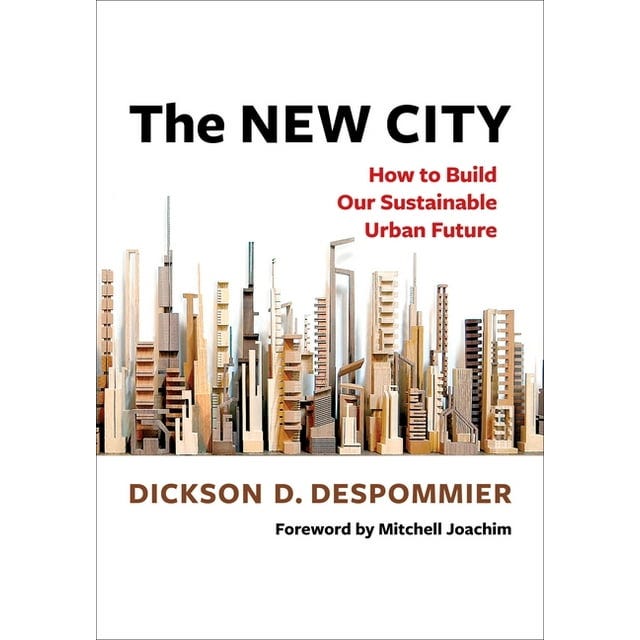The New City: How to Build Our Sustainable Urban Future
Dickson D. Despommier
Columbia University Press 2023
187 pages
As climate change becomes a more pressing problem, urban planners throughout the world are anticipating the adaptations cities will need in the near future, from flood protections and sea walls as ocean levels rise, to mitigating the urban heat island effect as cities grow warmer and warmer.
In 1960, twice as many people in the world lived in rural settings as in cities. Over the last 60 years demographic trends have shifted, with more and more people moving to and living in cities. Today, more than half the world’s population lives in cities, and this trend is predicted to continue. Cities will not only have to adapt to climate change, they will also need to be at the forefront of finding solutions for a more sustainable world.
We thus have to rethink everything about our cities, from how we construct them to how we supply city dwellers with food and water. This is the task Dickson D. Despommier has given himself with his new book, The New City: How to Build Our Sustainable Urban Future. Optimistic and well-illustrated with plenty of photographs, The New City is a good starting point, something of a primer, for students or anyone else who wants to know what it will take to create sustainable cities.
Despommier, an academic and author of several previous books, imagines cities that are largely self-sufficient, supplying much, if not all, of their needs for food, water, and energy. To achieve these ends, he outlines four pillars on which to build sustainable, carbon neutral cities.
By way of background, the concrete and steel currently used to construct our cities are major sources of atmospheric CO2. Both require large amounts of energy in their creation—from mining, kilning, and smelting to transportation—and thus both generate great amounts of carbon dioxide. Concrete is the third largest source of the world’s atmospheric CO2. The production of one ton of steel releases almost two tons of carbon dioxide.
Thus, for his first pillar, Despommier proposes that our building materials become carbon storing instead of carbon producing, replacing the concrete and steel with organic renewable materials, such as bamboo and wood. His thinking here encompasses everything from reviving construction techniques from hundreds of years ago to cross-laminated timber, a method for maximizing the strength of wood that was invented in 1994.
As Depommier points out for his second sustainability pillar, agriculture puts great pressure on water resources and has transformed 20 million square miles (seven times the area of Australia) of grasslands, forests, and other wildlands to farmland. Cities can reduce this pressure on the natural world by producing much of their own food, farming in open city lots and on rooftops. Despommier also suggests a move to indoor farming, such as aquaponics and something new to me, aeroponics, an ingenious method of suspending plants in a container and watering their dangling roots with nutrient mists. This method can be up to 90 percent more efficient than hydroponics.
If ivy has adorned our buildings, why can’t tomatoes, beets, and corn? Whole sides of buildings have been adapted and designed to grow crops, an innovation that Despommier embraces in this chapter and in one of his previous books.
The third pillar of sustainable cities is self-sufficiency in water use. As Despommier is an Emeritus Professor of Public Health in Environmental Health Sciences and Microbiology at Columbia University Medical Center, it is unsurprising that this is strongest chapter of his book.
He notes that New York City relies on a vast watershed and a well-designed, large-scale infrastructure for its water. New York’s water is so free from impurities that the city of close to nine million does not filter most of its water, though it is sanitized with chlorine and UV light. Yet even cities like New York, with what seem to be reliable, safe water sources, will have to develop ways of harvesting rainwater, like the rainwater-harvesting rooftops of Bermuda or developing huge inverted umbrellas that open and catch rainwater during storms.
Many of the world’s great cities lie along sea coasts, with a large number of them already desalinating ocean water for drinking. In some cases, folks are using great screens to harvest water directly from fog, dew, and other atmospheric sources. San Diego, where I live, harvests water from effluent. After filtering and multiple layers of purification, the water is safe for drinking. Depommier foresees such localized water sourcing methods to develop to the point that individual buildings recycle their own water.
The fourth of Despommier’s sustainability pillars is energy. While wind energy is somewhat problematic in urban settings, he gives much consideration to solar power. Something new to me is the potential to turn windows into electricity-generating sources. Despommier is also a proponent of clean, practical nuclear fusion—the transformation of hydrogen atoms into helium, the power source at the center of the sun. In my opinion, this technology is still decades and decades away, but Despommier anticipates it becoming part of our cities’ energy sources.
Despommier’s intention was to write a general introduction to his subject, not an exhaustive exegesis. (Indeed, each of his pillars could be the subject of an entire book.) I would have enjoyed the book more, however, if the attention paid to a few of the topics, such as energy storage, had been expanded a bit more.
I eat, sleep, and breathe sustainability and have read widely on the subject. Yet I learned something new in each chapter. Moreover, Despommier’s excitement for this topic is almost palpable. I wish more authors shared such enthusiasm in their books.
Notes on editing, proofreading and indexing
With one exception, where a building code was quoted at length—more distracting and confusing than illustrative, Miranda Martin edited this book with great care. Proofreading was also tops. I found no typos or errors in punctuation or grammar, and the indexing is comprehensive.





